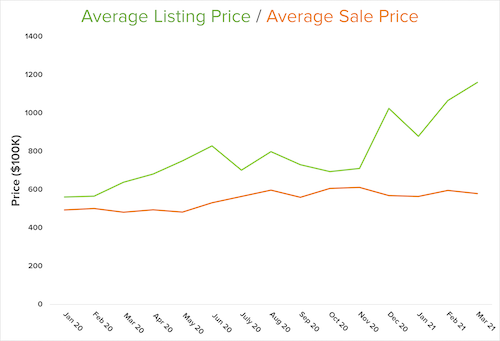Our local real estate market is on the rise, and we had an interesting first quarter after the seasonal slowdown. We’ve compiled North Kitsap’s key market highlights so you can stay current with our local real estate market.

Our Strong Seller’s Market
Our area continues to have low inventory from the surge in demand with people moving away from the bigger cities. As COVID-19 changes the way we work, there are still many eager buyers outnumbering sellers. Some buyers are being outbid either by price or by all-cash offers. Our local experts are here to help navigate this competitive market.
When you look at 2020’s first quarter compared to 2021’s first quarter, you can see that a similar growth trend after the holidays is repeated. However, growth has slowed relative to last year, with much of North Kitsap’s inventory sold during the Covid boom. And, our lower supply may indicate prices will rise. Get ready for the market to continue to heat up as we move from spring to summer.

This strong seller’s market is driving us toward an affordability ceiling. There is a growing sale price and listing divergence, shown in the chart below. Prices may soon be too high for many people to afford to buy a home here. Sellers, however, continue to benefit from our inventory shortage, asking for higher prices.

Affordability Issues and Market Insights
Matthew Gardner, Windermere’s Chief Economist, continues to track this affordability ceiling in his most recent Housing and Economic Update: “If the pace of home price growth continues, many households will start to be priced out” of what people can actually afford. As Gardner points out, we need more supply, and we need home prices to drop to alleviate this market strain.
Unfortunately, that might not happen fast enough for many hopeful homebuyers to make their dream a reality. Gardner reminds us that the cost of materials, recent storms, and the current housing market prices have all added to the cost of building new homes. This, in turn, will add to the listing price.
Additionally, Gardner points out that mortgage rates have risen after “a jump in bond yields has led rates to spike” as the country re-opens and economic activity increases. The resulting potential inflation causes the 10-year treasury interest rates to rise in hopes of attracting more buyers. However, it is still far below standard rates and shouldn’t be a concern for buyers right now.
Ultimately, it’s still a strong Seller’s Market with an overall low supply and high demand. We expect to continue to see issues with affordability as prices continue to climb.
 Facebook
Facebook
 X
X
 Pinterest
Pinterest
 Copy Link
Copy Link
